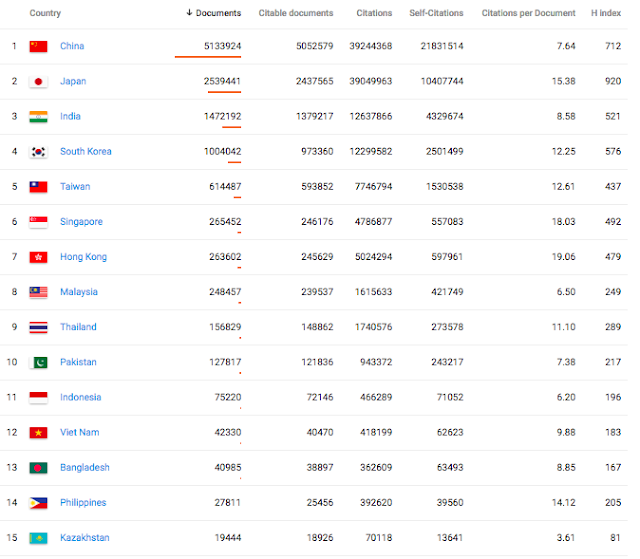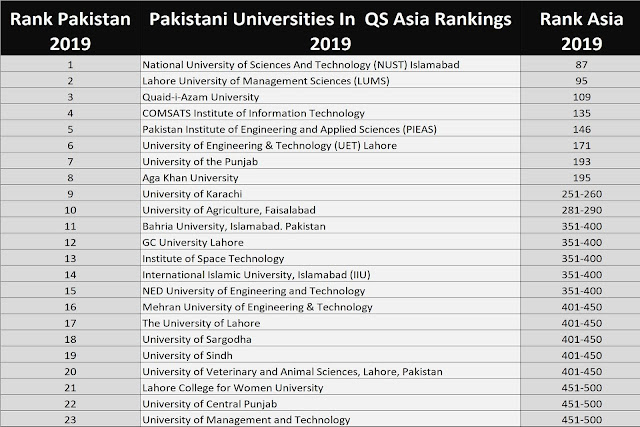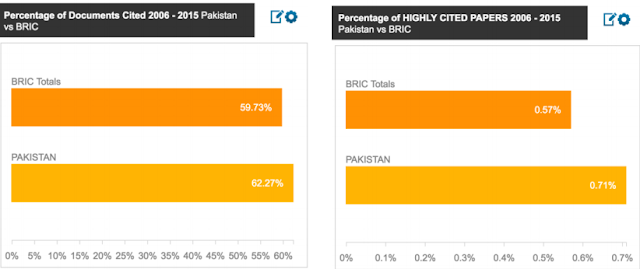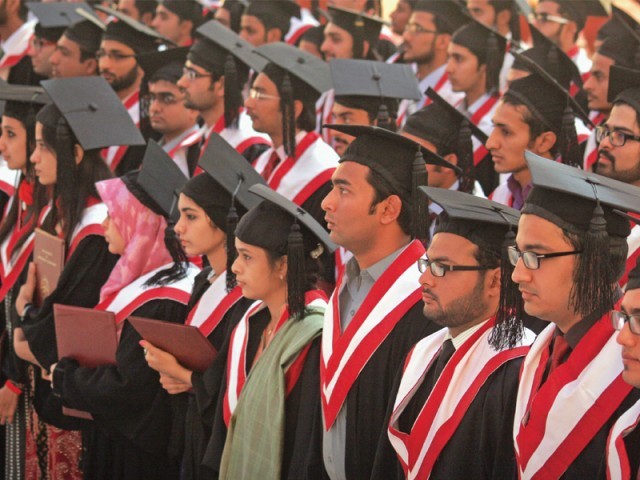PakAlumni Worldwide: The Global Social Network
The Global Social Network
Pakistani Universities Listed Among Asia's Top 500 Jump From 16 to 23 in One Year
British ranking agency Quacquarelli Symonds (QS) has ranked 23 Pakistani universities among the top 500 Asian universities for 2019, up from 16 in 2018. Other South Asian universities figuring in the QS top universities report are 75 from India, 6 from Bangladesh and 4 from Sri Lanka.
Top 500 Asian Universities. Source: QS University Rankings 2019 |
South Asia Ranking:
In terms of the number of universities ranking in Asia's top 500, Pakistan with its 23 universities ranks second in South Asia and 7th among 17 Asian nations topped by China with 112, Japan 89, India 75, South Korea 57, Taiwan 36, Malaysia 26, Pakistan 23, Indonesia 22, Thailand 19, Philippines 8, Hong Kong 7, Vietnam 7, Bangladesh 6, Sri Lanka 4, Singapore 3, Macao 2 and Brunei 2.
National University of Singapore ranked number one in Asia followed by University of Hong Kong and Nanyang Technological University in Singapore. Tsinghua University and Peking University—both from China—round off the top five list in Asia.
Pakistani Universities Ranked Among QS Asia Top 500. Source: QS Top... |
Pakistan's Top Universities:
National University of Sciences and Technology (NUST) is the top ranked university in Pakistan in QS Asia University Rankings 2019. NUST has moved up from 91st to 87th position. The second ranked university in Pakistan is Lahore University of Management Sciences (LUMS) at 95th position in the Asian ranking. These are the only two Pakistani universities ranked among the top 100 in the QS Asia University Rankings 2019. By contrast, India has 8 universities ranked among Asia's top 100. My alma mater NED University of Engineering and Technology is ranked 15th among Pakistan's 23 universities included in Asia's top 500 for 2019.
 |
| Top 15 Asian Nations Publishing Research. Source: SCIMAGO |
Pakistan has emerged as the country with the highest percentage of Highly Cited Papers compared with the BRIC countries (Brazil, Russia, India and China) in the last 10 years, according to Thomson Reuters. Pakistan has doe so despite the fact that its "R&D environment faced substantial economic challenges".
Pakistani Researchers Citations:
In a report titled "Pakistan: Another BRIC in the Wall", author Lulian Herciu says that Pakistan’s scientific productivity has quadrupled, from approximately 2,000 articles per year in 2006 to more than 9,000 articles in 2015. During this time, the number of Highly Cited Papers featuring Pakistan-based authors increased tenfold, from 9 articles in 2006 to 98 in 2015.
The author asserts that his report provides comparisons between Pakistan and BRIC nations taking a look at productivity and leveraging contextual indicators. His analysis points to the fact that Pakistan can be benchmarked with emerging and dynamic countries such as those in the BRIC (Brazil, Russia, India and China) group.
The Thomson Reuters report has found that, in 2012, "Pakistan's normalized Citation Impact was higher than that of all of the BRIC nations".
CERN Membership:
In 2014, Pakistan became the first Asian country and only the third in the world after Turkey and Serbia to be honored with CERN's associate membership. The status of associate member is a step before full membership. As an associate member, Pakistan is entitled to attend open and restricted sessions of the organization.
College and University Enrollment:
There are over 3 million students enrolled in grades 13 through 16 in Pakistan's 1,086 degree colleges and 161 universities, according to Pakistan Higher Education Commission report for 2013-14. The 3 million enrollment is 15% of the 20 million Pakistanis in the eligible age group of 18-24 years. In addition, there are over 255,000 Pakistanis enrolled in vocational training schools, according to Technical Education and Vocational Training Authority (TEVTA).
Graduation Day at NED Engineering University For 1300 Graduates in 2013 |
Pakistani universities have been producing over half a million graduates, including over 10,000 IT graduates, every year since 2010, according to HEC data. The number of university graduates in Pakistan increased from 380,773 in 2005-6 to 493,993 in 2008-09. This figure is growing with rising enrollment and contributing to Pakistan's growing human capital.
Higher education in Pakistan has come a long way since its independence in 1947 when there was only one university, the University of Punjab. By 1997, the number of universities had risen to 35, of which 3 were federally administered and 22 were under the provincial governments, with a combined enrollment of 71,819 students. A big spending boost by President Pervez Musharraf helped establish 51 new universities and awarding institutions during 2002-2008. This helped triple university enrollment from 135,000 in 2003 to about 400,000 in 2008, according to Dr. Ata ur Rehman who led the charge for expanding higher education during Musharraf years. There are 161 universities with 1.5 million students enrolled in Pakistan as of 2014.
R&D Investment:
Rise of research and publications at Pakistani universities began during Musharraf years when the annual budget for higher education increased from only Rs 500 million in 2000 to Rs 28 billion in 2008, to lay the foundations of the development of a strong knowledge economy, according to former education minister Dr. Ata ur Rehman. Student enrollment in universities increased from 270,000 to 900,000 and the number of universities and degree awarding institutions increased from 57 in 2000 to 137 by 2008. Government R&D spending jumped seven-fold as percentage of GDP from 0.1% of GDP in 1999 to 0.7% of GDP in 2007. It has since declined as percentage of GDP.
Summary:
British ranking agency Quacquarelli Symonds (QS) has ranked 23 Pakistani universities among the top 500 Asian universities for 2019, up from 16 in 2018. Other South Asian universities figuring in the QS top universities report are 75 from India, 6 from Bangladesh and 4 from Sri Lanka. Pakistani scientists and researchers are continuing to produced highly cited research in spite of serious economic and security challenges. Enrollment in higher education is rising and giving a boost to academic research. With better policy focus and more investment in higher education, Pakistan can make an even greater impact with its young demographics.
Related Links:
Rising College Enrollment in Pakistan
10 Pakistani Universities Among Asia's Top 300
Genomics and Biotech Research in Pakistan
Human Capital Growth in Pakistan
-
Comment by Riaz Haq on October 30, 2018 at 4:34pm
-
Pakistan is among the top 10 countries in Asia for publishing research papers in the period 1996-2017, according to Scimago:
https://www.scimagojr.com/countryrank.php?region=Asiatic%20Region
-
Comment by Riaz Haq on October 30, 2018 at 8:41pm
-
Number of technical and scientific papers published in journals by Pakistan increased from 1,420 in 2003 to 9,180 in 2016.
https://data.worldbank.org/indicator/IP.JRN.ARTC.SC?end=2016&lo...
-
Comment by Riaz Haq on November 10, 2018 at 10:18am
-
-
Comment by Riaz Haq on November 11, 2018 at 8:03pm
-
Pakistan's quality-adjusted scientific output (WFC) as reported in Nature Index has doubled from 18.03 in 2013 to 37.28 in 2017.
Pakistan's global ranking has improved from 53 in 2013 to 40 in 2017.
In the same period, India's WFC has increased from 850.97 in 2013 to 935.44 in 2017.
India's global ranking has improved from 13 in 2013 to 11 in 2017.
https://information.epfl.ch/files/content/sites/vpplnew/files/share...
-
Comment by Riaz Haq on April 13, 2019 at 10:26am
-
WEF Graduate skills, 2018
Pakistan ranks 51, above Italy (60), Russia (72), Turkey(94) and Brazil (124) among 140 countries.
https://twitter.com/spectatorindex/status/1117095097064095744
1. Switzerland
2. US
3. Netherlands6. Malaysia
7. Germany
20. Canada
28. UK
33. Indonesia
35. France
36. India
37. China
40. Japan
43. S Korea
50. Saudi
51. Pakistan
60. Italy
63. Mexico
72. Russia
94. Turkey
124. Brazil
135. Nigeria
136. Egypt(WEF)
-
Comment by Riaz Haq on June 29, 2019 at 4:56pm
-
Higher Education Development in Pakistan (HEDP) project was successfully negotiated between the Higher Education Commission (HEC) and the World Bank in May 2019, for a $400 Million IDA credit support. Subsequently, the project was approved by the World Bank Board in May.
https://academiamag.com/government-world-bank-signs-agreement/
The project has five components. The Component-1, Nurturing academic excellence in strategic sectors, will help promote relevant and cutting-edge research in universities in Pakistan, through competitive research, innovation, and commercialization grants to researchers and potential entrepreneurs from among faculty members, and current students.
The Component-2, Supporting decentralized HEIs for improved teaching and learning, aims to improve the quality of education delivered by Tier 2 universities and affiliated colleges through strengthening affiliation systems and technological interventions.
The objective of the Component-3 is to leverage technology to improve the teaching, learning and research environment in Pakistan and strengthen the existing IT resources available to institutions for research and higher education in Pakistan.
The Component-4, Higher education management information system and data-driven services, aims to improve the collection and use of data for national level policy-decisions while automating business processes in higher education institutions.The fifth component will support HEC in strengthening its core functions of regulation, capacity building, and funding of Pakistan’s higher education sector through strategic and targeted technical assistance, including the establishment of National Higher Education Academy.
-
Comment by Riaz Haq on January 25, 2025 at 8:49am
-
47 Pakistani universities rank in Times Higher Education’s world university rankings
https://gulfnews.com/world/asia/pakistan/47-pakistani-universities-...
Lahore: A total of 47 universities from Pakistan have secured spots in the 2025 Times Higher Education (THE) World University Rankings, marking a significant achievement for the country's higher education sector.
Quaid-i-Azam University Islamabad has earned a place in the 401-500 range, leading the pack among Pakistani institutions.
Several others, including Air University Islamabad, Capital University of Science and Technology, COMSATS University Islamabad, Government College University Faisalabad, National University of Sciences and Technology Islamabad, Sukkur IBA University, University of Engineering and Technology Taxila, and University of Malakand Dir Lower, are ranked between 601 and 800.
Other notable universities, such as Abdul Wali Khan University Mardan, International Islamic University Islamabad, Khwaja Fareed University of Engineering and Information Technology Rahim Yar Khan, Lahore University of Management Sciences, PMAS Arid Agriculture University Rawalpindi, The Islamia University of Bahawalpur, University of Central Punjab Lahore, University of Engineering and Technology Peshawar, University of Gujrat, University of Lahore, University of Management and Technology Lahore, University of the Punjab Lahore, and University of Veterinary and Animal Sciences Lahore, are ranked between 801 and 1000.
In addition, 12 universities are ranked between 1001 and 1200, eight institutions fall between 1201 and 1500, and five universities are placed in the 1501+ range.
Comment
You need to be a member of PakAlumni Worldwide: The Global Social Network to add comments!
Twitter Feed
Live Traffic Feed
Sponsored Links
South Asia Investor Review
Investor Information Blog
Haq's Musings
Riaz Haq's Current Affairs Blog
Please Bookmark This Page!
Blog Posts
Pakistan Household Survey HIES 2024-25 Raises More Questions Than It Answers
Recently released HIES 2024-25 household integrated economic survey by Pakistan Bureau of Statistics (PBS) raises more questions than it answers. For example, it shows that Pakistani households are buying lower amounts of basic food ingredients like wheat, meat and eggs in the last four years, implying that people are eating less to cover other expenses, like electricity and gas. But it doesn't explain why the households have reported significantly lower purchases of these items than…
ContinuePosted by Riaz Haq on January 6, 2026 at 5:00pm
Happy New Year 2026: Pakistan's Year 2025 in Review
As we enter the year 2026, it is time to review the year 2025 and wish you all Happy New Year 2026! May it bring peace, prosperity and happiness to all!!
The year 2025 saw Pakistan defeat a brazen Indian attack on its soil, while reviving its economy and…
ContinuePosted by Riaz Haq on December 30, 2025 at 9:30pm — 10 Comments
© 2026 Created by Riaz Haq.
Powered by
![]()







Pakistan ranks 40 with quality-adjusted scientific output of 37.28. India ranks 11 with 935. Malaysia ranks 61 with 6.73 and Indonesia ranks 63 with 6.41. Bangladesh ranks 100 with 0.81. Sri Lanka ranks 84 with 1.36. US leads with almost 15,800, followed by China's 7,500, Germany 3,800, UK 3,100 and Japan 2,700.
The Nature Index is a database of author affiliation information collated from research articles published in an independently selected group of 82 high-quality science journals. The database is compiled by Nature Research. The Nature Index provides a close to real-time proxy of high-quality research output and collaboration at the institutional, national and regional level.
http://www.unz.com/akarlin/nature-index-2018/